Exosomes from Hepatitis C Infected Patients Transmit HCV Infection and Contain Replication Competent Viral RNA in Complex with Ago2-miR122-HSP90
Since its first isolation and identification in 1989, Hepatitis C virus (HCV), has caused significant disease burden to humans worldwide. So far, there is no vaccine against HCV, and neutralizing antibody therapies to block receptor–mediated transmission of HCV to liver cells have so far achieved limited therapeutic benefits. This indicates that HCV can transmit infection via receptor-independent mechanisms. Evidence suggests that small host extracellular vesicles (exosomes) can mediate receptor-independent transfer of genetic material between cells, though their role in HCV transmission remains uncertain. Here, we found that the HCV virus can utilize host exosomes to transmit infection to naïve liver cells, even in the presence of potent blocking anti-HCV receptor antibody treatments. Additionally, we identified alternative treatment strategies that can block host exosomes from transmitting HCV infection. Our study provides novel insights to an alternative mechanism of HCV transmission that can compromise anti-HCV immune therapies and proposes potential therapeutic approaches to block exosome-mediated transmission of HCV infection.
Published in the journal:
. PLoS Pathog 10(10): e32767. doi:10.1371/journal.ppat.1004424
Category:
Research Article
doi:
https://doi.org/10.1371/journal.ppat.1004424
Summary
Since its first isolation and identification in 1989, Hepatitis C virus (HCV), has caused significant disease burden to humans worldwide. So far, there is no vaccine against HCV, and neutralizing antibody therapies to block receptor–mediated transmission of HCV to liver cells have so far achieved limited therapeutic benefits. This indicates that HCV can transmit infection via receptor-independent mechanisms. Evidence suggests that small host extracellular vesicles (exosomes) can mediate receptor-independent transfer of genetic material between cells, though their role in HCV transmission remains uncertain. Here, we found that the HCV virus can utilize host exosomes to transmit infection to naïve liver cells, even in the presence of potent blocking anti-HCV receptor antibody treatments. Additionally, we identified alternative treatment strategies that can block host exosomes from transmitting HCV infection. Our study provides novel insights to an alternative mechanism of HCV transmission that can compromise anti-HCV immune therapies and proposes potential therapeutic approaches to block exosome-mediated transmission of HCV infection.
Introduction
Hepatitis C virus (HCV) infection is one of the leading causes of liver disease with over 170 million individuals chronically infected worldwide [1], [2]. Severe complications including fibrosis, cirrhosis, and hepatocellular carcinoma are among the long-term effects of HCV infection, making liver transplantation the ultimate choice of treatment for advanced liver disease [3]. Even with successful liver transplantation, patients face eminent HCV re-infection of the newly transplanted liver. Recent therapies with anti-HCV E1-E2 or other neutralizing antibodies that attempted to block HCV transmission achieved only limited success [4]–[7].
HCV is a positive-sense single-stranded RNA enveloped virus of the Flaviviridae family. The 9.6 kb HCV genomic RNA encodes a single polypeptide that is proteolytically cleaved to structural (core, E1, and E2) and non-structural (p7, NS2, NS3, NS4A, NS4B, NS5A and NS5B) HCV viral proteins [8]. The HCV viral envelope E1 and E2 proteins engage numerous host cell proteins for viral entry including CD81 [9]–[11]. CD81 interaction with HCV E1/E2 is critical in HCV entry and anti-CD81 or anti-E1/E2 antibodies have been shown to block HCV virus entry [7], [12]. Given the importance of these viral envelope proteins in regulating HCV infection, numerous immune therapies have been developed to specifically target and/or neutralize HCV envelope proteins [7], [13]–[15]. Targeted antibody therapies have offered limited success in preventing liver allograft infection by HCV. Recently, a potent human-derived monoclonal antibody was demonstrated to effectively prevent and treat HCV1 infection in chimpanzees [7]. However, the same antibody was not completely effective in humans [7], raising the possibility of other mechanisms of virus entry into hepatocytes. Previous reports have suggested receptor independent transmission of HCV [6], [16], though the precise mechanisms or possible therapeutic strategies remain to be explored.
Exosomes are a subpopulation of extracellular vesicles that originate from multivesicular bodies (MVBs), ranging from 40–150 nm in size and are produced by most cell types. These vesicles can be detected in blood, urine, and other body fluids [17]. Exosomes can modulate signal transduction, antigen presentation to T-cells, and transmission of genetic material between cells [18]. Over the past decade, a great body of evidence shows that exosomes can be secreted into the extracellular space and can mediate indirect cell-to-cell communication by transferring bio macromolecules, functional proteins, and RNAs between cells [19], [20].
HCV infection occurs via cell free virus and direct cell-to-cell transmission [6]. Indirect cell-to-cell transmission is another pathway to consider. Previously, HCV viral RNA has been identified in supernatant of HCV-SGR cells [21] and exosome-like structures have been detected in the supernatant of HCV infected cells [22] and in the plasma of HCV-infected patients [23]. Recently, Dreux et al (2013) showed that HCV-RNA-containing exosomes can mediate transfer of RNA to co-cultured plasmacytoid dendritic cells (pDCs) and trigger the production of type I interferon (IFN) in vitro [24].
Here we tested the hypothesis that exosomes derived from HCV infected hepatocytes or from the sera of HCV infected patients carry viral RNA and exploit the cellular exosomal delivery system to mediate receptor-independent HCV transmission to hepatocytes. We found that exosomes derived from HCV infected Huh7.5 cells and HCV infected patients contained HCV RNA that induced active infection in primary human hepatocytes (PHH). These exosomes were rich in replication-competent HCV-RNA in complex with miR-122, Ago2, and HSP90; and mediated HCV transmission independent of CD81, SB-RI and APOE. Mechanistically, functional inhibition of miR-122, HSP90 or modification of cellular micro-environmental pH using a vacuolar-type H+-ATPase (V-ATPase) and proton pump inhibitor significantly suppressed the capacity of exosomes to mediate HCV transmission.
Results
Separation of HCV infected exosomes from free HCV viruses and characterization of exosomes
Given our interest to investigate the capacity of exosomes derived from HCV J6/JFH-1-infected Huh7.5 cells and serum of HCV infected patients to mediate active transmission, we had to efficiently separate exosomes from the free HCV virus. Because HCV virions and exosomes have very similar sizes and densities, the traditional ultracentrifugation and sucrose gradient isolation method is insufficient for isolating pure exosomes free of virus contamination. To overcome this limitation, we optimized a CD63 immuno-magnetic isolation method to purify exosomes from cell culture supernatants of HCV J6/JFH-1 infected Huh7.5 cells and sera of HCV infected patients. Briefly, after serial filtration (1 µm, 0.44 µm and 0.22 µm) of supernatants, exosomes were initially isolated using Exoquick. To further purify exosomes and exclude other microparticles or free HCV contamination, Exoquick-isolated exosomes were subjected to immuno-magnetic selection with CD63, a selection marker of exosomes. This protocol was verified by analysis for other exosomal markers by western blotting (CD9 and CD81), electron microscopy, and Nanoparticle tracking analysis (NTA) (Figures S1A, S1B & S1C). The Exoquick-CD63 immuno-magnetic selection procedure recovered more exosomes compared to, ultracentrifugation-CD63 immuno-selection of exosomes (Fig. 1A & 1B); based on this observation we used the Exoquick followed by CD63 immuno-magnetic selection for subsequent experiments. We observed that in a fixed total volume there were significantly more free HCV viral particles compared to the number of exosome particles in HCV J6/JFH-1 infected Huh7.5 cell supernatants [approximately 7∶1 ratio] and in HCV infected patient serum samples [approximately 4∶1 ratio] (Fig. 1C). We also found higher HCV viral copy numbers in the free virus fraction compared to exosomes in J6/JFH-1 infected Huh7.5 cell supernatants (Fig. 1D) and HCV patients' serum (Fig. 1E). Purified exosomes were analyzed by transmission electron microscopy, demonstrating their vesicular shape and size range between 50 and 100 nm (Figure S1A). Further analysis with NanoSight demonstrated comparable histogram size plots of exosomes from culture supernantants of HCV J6/JFH-1 infected Huh7.5 cells and exosomes from serum of HCV infected patients (Figure S1B & S1C).
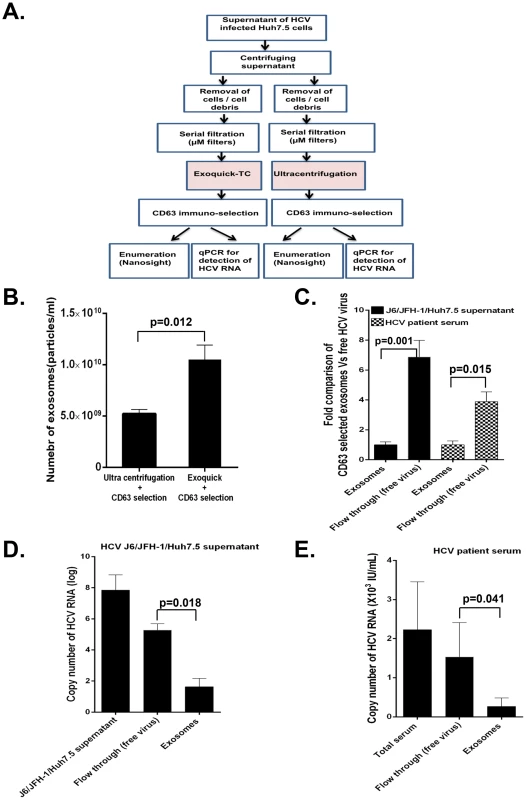
To rule out exosome contamination with free HCV virus, we carried out a simulation experiment mixing cell free HCV virus with uninfected exosomes from Huh7.5 cell culture supernatants for 24 h and re-isolated exosomes with Exoquick followed by CD63 immuno-selection or ultracentrifugation followed by CD63 immuno-selection. The uninfected exosomes exposed to free HCV virus showed no detectable HCV viral RNA while HCV RNA was present in the flow through following immuno-magnetic CD63 selection of exosomes (Fig. 2A & 2B). Further characterization of exosomes and free virus showed that isolated exosomes contained Apolipoprotein B (APOB) which was not present in cell free HCV viruses (Fig. 2C). Apolipoprotein E (APOE) was found to be associated to a large extent with HCV virus fraction and significantly lower in exosomes compared to cell free virus fractions (Fig. 2D). These observations suggest that our purified exosomes were to a large extent devoid of lipo-viral contamination. RNase H treatment to destroy free RNA in the cell free virus concentrate and isolated exosomes from HCV infected Huh 7.5 cells failed to prevent transfer of HCV infection to naïve cells, thus ruling out the possibility of envelope free viral RNA mediating HCV infection. These data indicate that both HCV derived exosomes and HCV virus are resistant to RNase treatment similar to the previous report [25] and still cause productive infection even after RNase treatment (Figure S2).
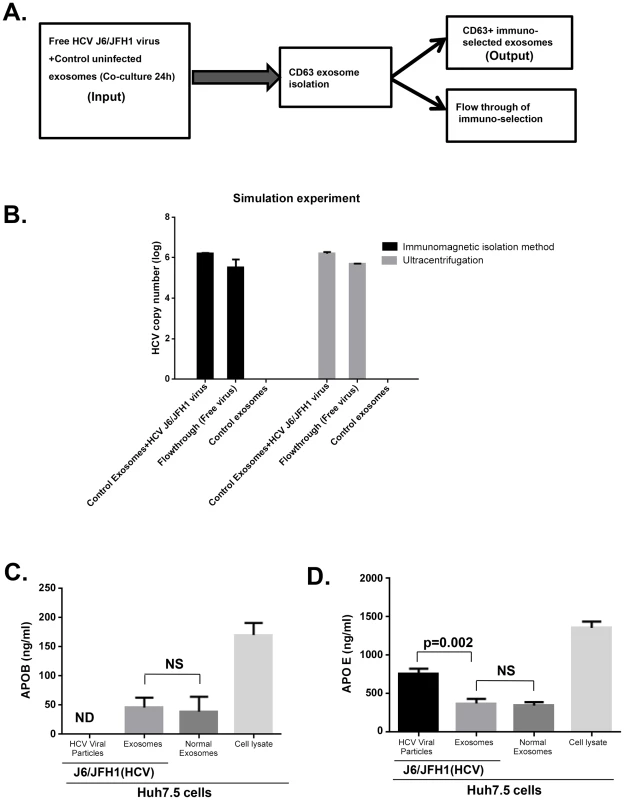
Exosomes from serum of HCV infected patients or HCV J6/JFH-1 infected Huh7.5 cells contain HCV RNA, miR-122, Ago2, and HSP90
First, we established efficient methods for exosome purification using Exoquick followed by CD63-based isolation as described above. These exosomes were devoid of free HCV virus contamination as detailed. Exosomes isolated from sera of some HCV-infected patients or supernatants of HCV J6/JFH1 infected Huh7.5 cells contained comparable HCV RNA content for the same number of free HCV viral particles compared to the same number of HCV exosome particles (Fig. 3A). These observations allowed us to use the same number of infectious HCV viral particles and HCV exosomes for subsequent experiments. Treatment-naïve and non-responder (interferon plus ribavirin) patients with active HCV infection had detectable HCV RNA in serum-derived exosomes (Fig. 3B). In contrast, treatment responders, who cleared HCV infection, showed no detectable HCV in exosomes (Fig. 3B). Additionally, interferon alpha treatment of Huh7.5 cells had no effect on the number of exosomes released from hepatocytes (Figure S3) compared to untreated cells.
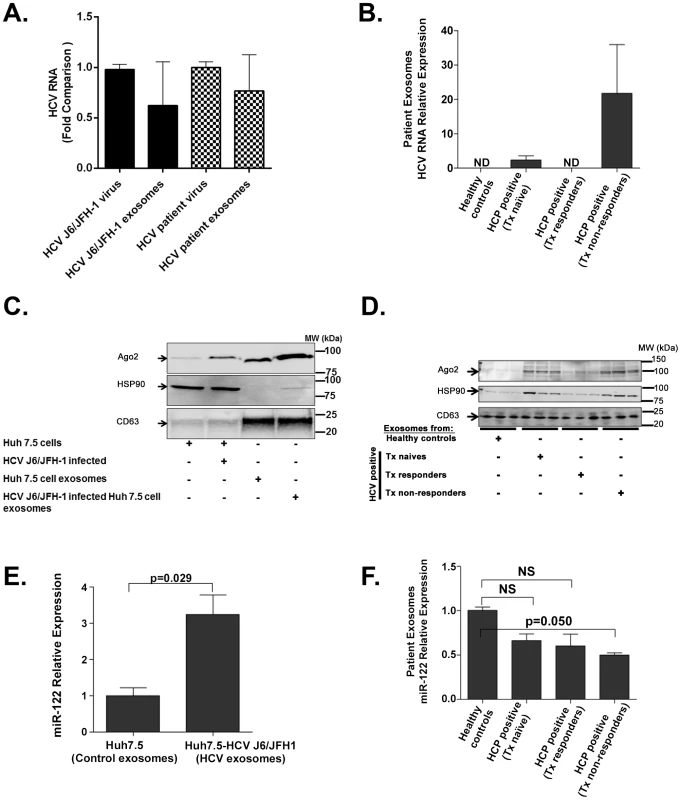
Recent studies have consistently demonstrated that miR-122, Ago2, and HSP90 enhance HCV replication [26]–[30]. We found that HCV J6/JFH-1 infected Huh7.5 cells produced exosomes that are enriched in Ago2 and contain barely detectable HSP90 protein compared to control exosomes from Huh7.5 cells (Fig. 3C). Interestingly, exosomes from HCV infected treatment-naïve and treatment non-responder individuals, but not treatment responders, were rich in Ago2 and HSP90 (Fig. 3D) compared to control healthy uninfected individuals. GW182 a RISC complex protein which we recently identified as an enhancer of HCV replication associated with alcohol use [31], was not detected in exosomes in our experimental conditions.
Micro RNA-122, a host factor utilized by HCV for replication, was present in exosomes isolated from both HCV J6/JFH-1 infected Huh7.5 cells and HCV-infected individuals (Fig. 3E & 3F). We observed that exosomes from HCV J6/JFH-1 infected Huh 7.5 cells showed higher levels of miR-122 compared to exosomes from non-infected cells (Fig. 3E), while exosomes from HCV-infected patients contained lower miR-122 levels compared to those from healthy controls (Fig. 3F).
Exosomes from HCV treatment naïve patients or culture supernatants of HCV J6/JFH-1 infected Huh7.5 cells transmit HCV infection
Exosomes were recently shown to mediate retroviral infection independent of envelope protein-receptor interaction [32]. More recently, exosomes from Huh7.5 infected cells were found to induce type I interferon production in dendritic cells [24].
Observation of the presence of HCV RNA in exosomes prompted us to evaluate if exosomes from J6/JFH-1-infected hepatocytes or from HCV infected individuals could transmit infection to uninfected cells. We found that exosomes derived from supernatants of HCV J6/JFH-1 infected Huh7.5 cells mediated HCV infection after co-culture with uninfected Huh 7.5 cells (Fig. 4A and Figure S4) which could be inhibited by Telaprevir (VX-950) an NS3.4A serine protease inhibitor (Fig. 4B). Further, exposure of primary human hepatocytes (PHH) to exosomes isolated from treatment-naïve or treatment non-responder HCV infected patients resulted in effective virus infection and replication as indicated by detectable HCV RNA in the culture supernatants (Fig. 4C). Active virus replication after infection of PHH with HCV exosomes was indicated by a 2–3 log increase in HCV copy numbers in PHH at 48 hours after infection compared to the initial HCV copy numbers introduced by the HCV exosomes used for induction of infection (Fig. 4D). Additionally, the use of Telaprevir (VX-950), an NS3.4A serine protease inhibitor, could inhibit HCV replication caused by free virus and HCV exosomes in infected PHH (Fig. 4E).
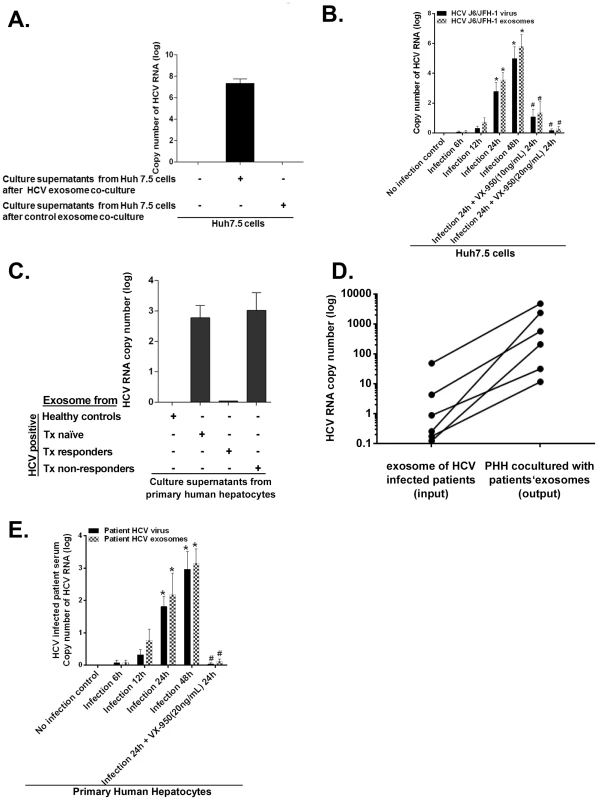
Exosomes mediate CD81, SB-RI and APOE receptor-independent transmission of HCV
CD81, SB-RI, APOE and HCV E1/E2 proteins are important host and viral molecules for HCV infection [33]. We and others have shown that anti-CD81 and anti-HCV E1/E2 antibodies can block HCV infection [7], [12], [34]; however, in some instances antibody therapy in patients could not fully prevent HCV infection [16]. Based on these observations, we tested whether the presence of anti-CD81 antibodies would block exosome and cell free virus transmission of HCV. We found that anti-CD81 pre-treatment effectively blocked free HCV virus infection of target Huh7.5 cells, indicated by significantly low HCV RNA expression (Fig. 5A) and by lack of expression of HCV NS3 protein (Fig. 5B). However, exosomes containing HCV RNA could still transmit HCV infection despite anti-CD81 antibody pre-treatment (1∶50 dilution) (Fig. 5A & 5B). These findings were validated in primary human hepatocytes where anti-CD81 pre-treatment significantly inhibited free HCV virus infection but failed to prevent patient exosome-mediated HCV transmission (Fig. 5C & 5D). Additionally, SB-RI (Fig. 5E) or APOE (Fig. 5F) antibody pre-treatment could block HCV J6/JFH-1 free virus transmission but not HCV-exosome transmission of HCV to naïve Huh7.5 cells (Fig. 5E & 5F).
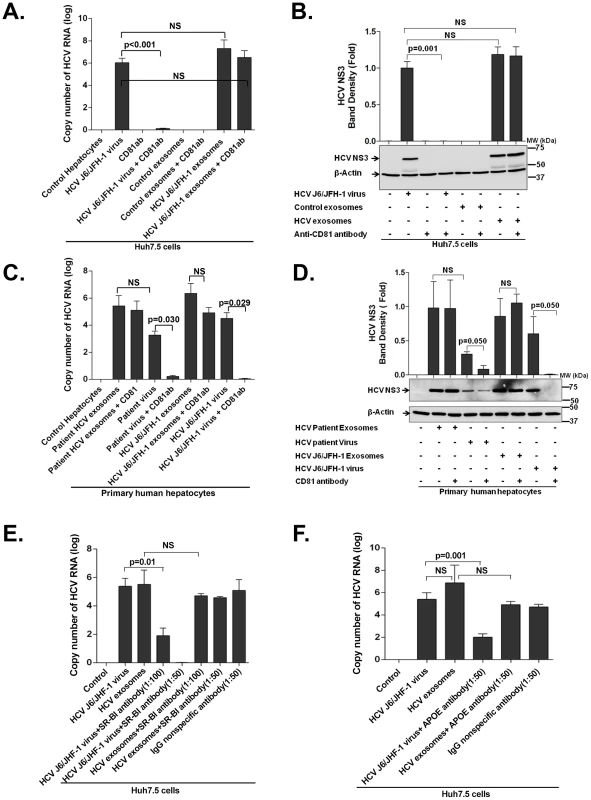
We next tested CD81-deficient Huh7.25-CD81 cells [35] and found that HCV exosomes could still mediate HCV transmission but infection rate with the free virus entry was significantly diminished (Fig. 6A). In the parental Huh7.0 cells, both exosomes and free HCV virus resulted in comparable extent of HCV infection (Fig. 6B). HCV E1 and E2 envelope glycoproteins which can modulate HCV infection [36] have been shown to associate with exosomes [23], thus we tested if anti-HCV E2 antibody treatment could block HCV transmission by exosomes. We found that anti-HCV E2 antibody treatment of HCV J6/JFH-1 virus could significantly block HCV transmission by free HCV particles but not by exosomes (Fig. 6C).
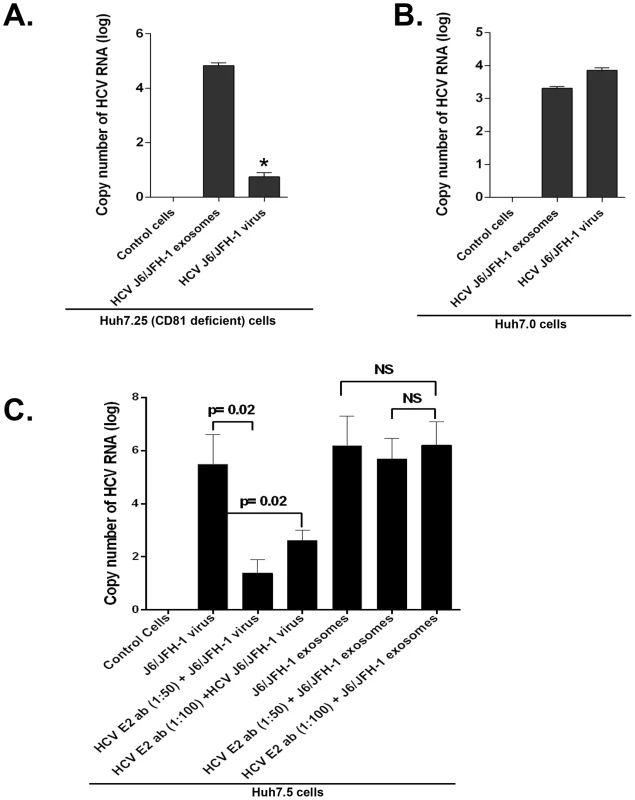
Exosomes derived from HCV infected patient serum and Huh7.5-HCV J6/JFH-1 cells contain replication-competent HCV RNA in complex with Ago2-miR-122
Recent reports have demonstrated the role of Ago2 and miR-122 in enhancing HCV replication when bound to the 5′-UTR of HCV dsRNA [26]. We observed that the same MOI of free HCV viruses or HCV-exosomes resulted in a trend (but not statistically significant) of greater HCV transmission by exosomes compared to the cell free virus (Fig. 5). Based on this observation, we surmised that exosomes might contain replication-competent RNA in association with RISC complex proteins that could enhance HCV RNA stability and enhance viral replication [26], [37], [38]. Using RNA-chromatin immunoprecipitation (RNA-ChIP) analysis of exosomes isolated from HCV J6/JFH-1 infected Huh 7.5 cells or HCV infected patients after Ago2 pull-down, we found that Ago2 was associated with miR-122 (Fig. 7A), positive sense HCV RNA (Fig. 7B upper panel) and, in some cases, negative sense HCV RNA (Fig. 7B lower panel). Using free HCV virus RNA and RNA from HCV infected cells we confirmed primer specificity for detection of positive and negative sense HCV RNA (Figures S5A & S5B). Additionally, using co-immuno precipitation, we confirmed that HSP90 and Ago2 formed complexes within the HCV containing exosomes likely providing further stabilization of the HCV RNA-replication complex (Fig. 7C) [39].
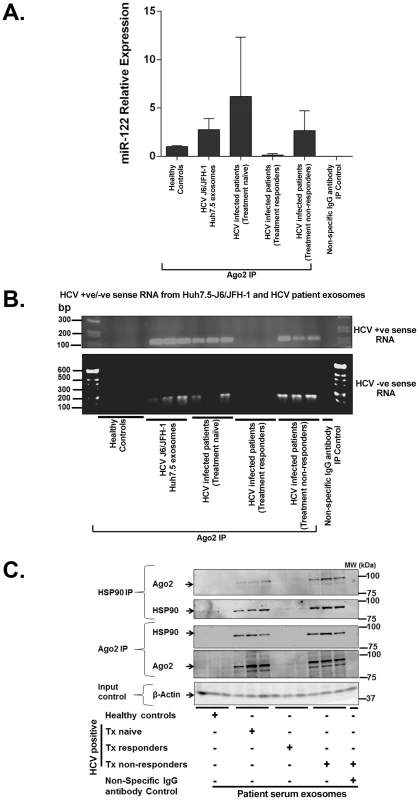
These striking observations indicate that serum exosomes from some HCV infected treatment-naïve patients contain positive sense RNA of HCV virus and are able to transmit active HCV infection. We found that, even in the few patients where we could not detect viral RNA in the exosomes due to the limitation of the sensitivity of the Real Time PCR method (Table 1 & 2), HCV infection of PHH was still evident (Fig. 4C). Furthermore, replication competent, negative sense HCV RNA was also present in some treatment-naïve and in all non-responder patients (Table 1 & 2).


Inhibition of miR-122 or HSP90 blocks exosome-mediated transmission of HCV in Huh7.5 cells
Given that exosomes from HCV-infected treatment-naïve and treatment non-responders contained Ago2 in complex with miR-122, and HSP90, we tested the effect of miR-122 or HSP90 inhibitors which have been suggested for HCV treatment [29], [37], [40]. Delivery of a miR-122 inhibitor resulted in about 50% reduction in miR-122 levels in Huh7.5 cells that is significant considering the high abundance of miR-122 in hepatocytes (Fig. 8A). However, inhibition of miR-122 in Huh7.5 cells prior to infection with HCV exosome failed to significantly suppress HCV transmission (Fig. 8A). Given that exosomes harbored HCV in complex with miR-122/HSP90, we hypothesized that miR-122 in the exosomes provides advantages for HCV transmission. To test this hypothesis, we transfected HCV-exosomes with a miR-122 inhibitor or control, washed and re-purified the miR-122 inhibitor- or control inhibitor-loaded HCV-exosomes and used them for infection of naïve Huh7.5 cells. The miR-122 inhibitor-loaded HCV-exosomes resulted in a significant reduction in intracellular miR-122 levels in Huh7.5 cells (Fig. 8B). Importantly, we found reduced virus transmission by HCV-exosomes loaded with the miR-122 inhibitor as indicated by decreased HCV NS3 protein compared to the controls (Fig. 8C).
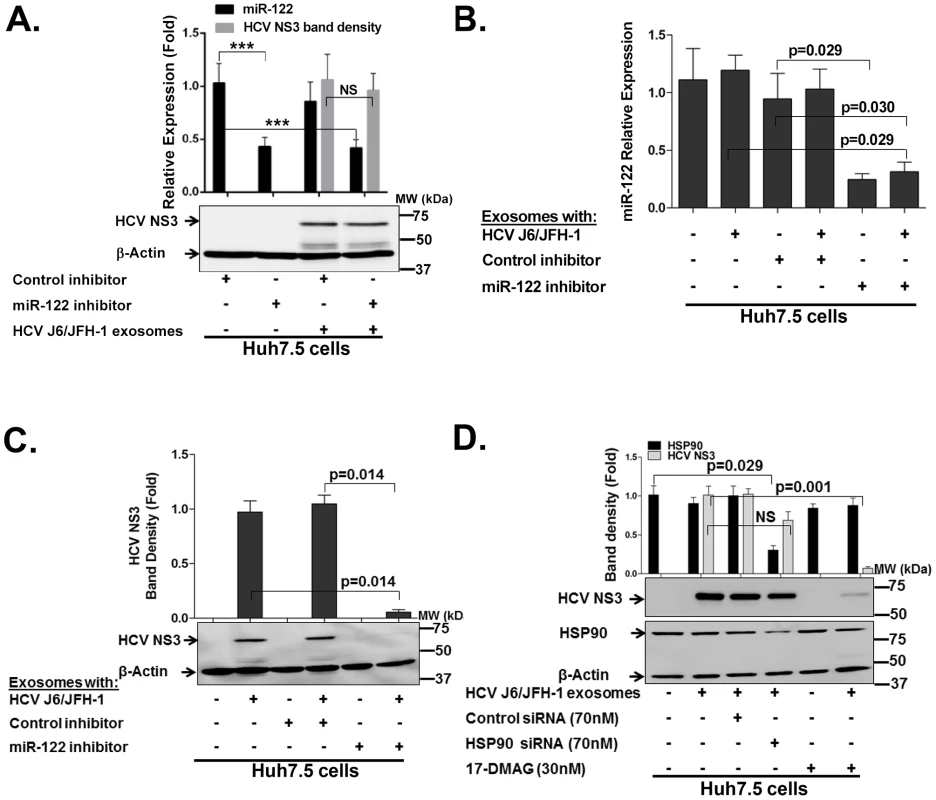
We also assessed the potential of the HSP90 activity inhibitor, 17-DMAG, or HSP90 siRNA treatment to modulate HCV infection transmitted by exosomes (Fig. 8D). We found that DMAG treatment but not HSP90 siRNA treatment could significantly block exosome-mediated HCV transmission (Fig. 8D).
Vacuolar-type H+-ATPase inhibitor and proton pump inhibitor can block exosome and free virus transmission of HCV to Huh7.5 cells
Previous data showed that viral HCV entry and subsequent infection can be prevented by administering vacuolar-type H+-ATPase inhibitor [41]. Moreover, Meertens et al [42] reported that entry of HCV pseudoparticles (HCVpp) was efficiently blocked by bafilomycin A1, a specific vacuolar-type H+-ATPase inhibitor, which neutralizes the pH in early endosomes and injures progression of endocytosis beyond this level. Exosome entry through endocytosis is reported to be pH dependent in the traffic of tumor exosomes in regulating both their release and uptake by tumor cells [43]. Based on these reports, we set up an in vitro model utilizing a vacuolar-type H+-ATPase inhibitor (bafilomycin A1) or a proton pump inhibitor (Lansoprazole) to study the role of low pH in favoring HCV infected exosome uptake in Huh 7.5 cells. We found that low pH plays a role in the entry of infected exosome into the Huh 7.5 cells and infection by HCV infected exosomes can be blocked using vacuolar-type H+-ATPase or a proton pump inhibitor. Our data show that both Lansoprazole (Fig. 9A & 9B) and bafilomycin A1 (Fig. 9C & 9D) could significantly inhibit HCV transmission by exosomes and cell free HCV viruses to Huh7.5 hepatoma cells in a dose-dependent manner without causing significant cellular cytotoxicity (Figures S6A & S6B).
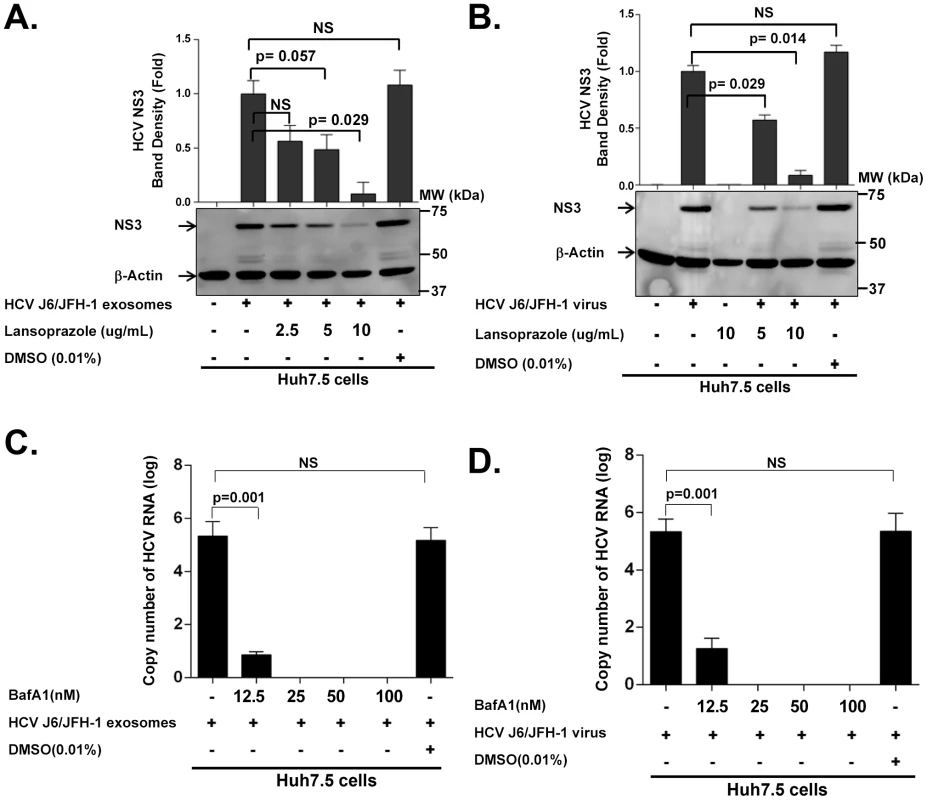
Discussion
Exosomes are found in different biofluids and represent a small (40–150 nm) subpopulation of extracellular vesicles of endocytic origin released by almost all cell types. They act as natural carriers of genetic materials, namely miRNA, mRNA and proteins [44], [45]. Notably, exosomes have been shown to mediate disease transmission caused by bacteria, infectious prion protein, and viruses [46], [47]. In the context of HCV, recent studies showed that hepatocyte-derived exosomes containing viral RNA induced production of IFN-α in plasmacytoid dendritic cells (pDCs) in vitro [24]. In this study, we demonstrate that circulating exosomes derived from sera of treatment-naïve HCV infected individuals or HCV treatment non-responder individuals contain HCV virus that can transmit active HCV infection to primary human hepatocytes, confirmed with the observation of a 2–3 log increase in HCV copy numbers in PHH compared to the initial HCV copy numbers in exosomes used for infection indicated virus replication. A recent study also reported exosome-mediated transmission of HCV in Huh7.5 cells [48]. Our observations confirmed and extended a recent report that also found that exosomes derived from HCV J6/JFH-1 infected Huh7.5 cells can shuttle virus to normal Huh7.5 cells and establish a productive infection. Using a stringent isolation methodology of serial filtration followed by density separation and immune magnetic CD63-positive exosome isolation, we optimized a method of HCV exosome isolation without carryover of free virus thereby further underscoring the capacity of exosomes to transmit HCV infection.
Our findings showed for the first time that exosomes from sera of HCV infected patients or culture supernatants of HCV J6/JFH-1 infected Huh7.5 cells can mediate effective CD81, SB-RI, HCV E2 and APOE -independent HCV transmission to hepatocytes. A recent report by Ramakrishnaiah et al [48] indicated that exosomes can mediate partial CD81-independent HCV transmission in Huh7.5 cells, however in that study cell free HCV transmission could not be fully excluded. Our results indicate that exosomes that are devoid of free virus contamination are capable of HCV transmission even in the presence of a potent anti-CD81, anti-SB-RI, anti-HCV E2 and anti-APOE antibody treatment and in CD81-deficient cells. These observations could explain in part why neutralizing antibodies or therapies that target host/viral protein interactions at the level of cell entry can be compromised and likely occur via cell-to-cell transmission by exosomes.
Given that infections with HCV-exosomes compared to the same MOI of free HCV virus particles, showed a tendency for higher levels of HCV transmission to hepatocytes, it was unclear if these exosomes contained replication competent HCV RNA, factors that enhanced virus replication or facilitated mechanisms of exosomes entry to target cells. Recently, reports have consistently demonstrated that RISC-like complexes involving Ago2 and miR-122 can protect the HCV 5′ internal ribosome entry site (5′ IRES) and enhance HCV replication [26], [38]. We found higher miR-122 expression in HCV J6/JFH-1 infected Huh7.5 cells derived exosomes compared to HCV infected patient exosomes and their respective controls, possibly as a result of suppressed interferon production in Huh7.5 cells since Huh7.5 cells harbor a mutation in the dsRNA sensor retinoic acid-inducible gene-I (RIG-I) [49]–[51]. However, using RNA ChIP analyses we found that exosomes from HCV J6/JFH-1 infected Huh 7.5 cells and exosomes from the two patient groups that have active infection, treatment-naïve and treatment non-responders, showed increased proportion of miRNA-122 in complex with Ago2. Additionally, it was remarkable that Ago2 and miR-122 bound to the HCV 5′-UTR was also in association with HSP90 which has been shown to stabilize RISC complexes [52] and potentially increase HCV replication. Our observations support a hypothesis whereby exosomes mediate higher HCV transmission because they contain replication-competent viral RNA, as well as, known HCV replication enhancers- Ago2 [26], miR-122 [26], [29], [37], and HSP90 [37], [53], [54]. Additionally, HCV RNA in exosomes might mediate higher levels of infection possible due to the higher stability of HCV RNA when associated with Ago2 and miR-122 as suggested by Shimakami et al [39].
The presence of host proteins within HCV-exosomes is a clever strategy by the virus to ensure effective replication once in the endoplasmic reticulum (ER) given that the ER does not contain these exosomal proteins [55]. Our novel findings may translate and offer possible clinical implications to HCV treatment resistance with interferon/ribavirin given that exosomes from HCV-infected treatment resistant patients contained HCV negative sense RNA, which is mostly associated with replication-competent HCV RNA. Strikingly, only some of the treatment-naïve patients with HCV positive-sense RNA detected in their exosomes contained negative-sense HCV RNA (Table 2). Importantly, none of HCV treatment responder patients harbored detectable HCV RNA in their serum-derived exosomes consistent with their status of HCV viral clearance. The implication of our findings needs additional clinical follow-up to determine whether treatment and/or disease outcome using anti-HCV immune therapies would be influenced by the composition of serum-derived exosomes in HCV infected patients.
Based on our novel findings that exosomes can mediate virus transmission via CD81, SB-RI and APOE -independent mechanisms potentially compromising the efficacy of HCV immunotherapies, we next aimed to test therapeutic alternatives. We analyzed the potential use of miR-122 inhibition and DMAG treatment both of which have been successfully explored for HCV treatment but not yet assessed in the context of exosome-mediated HCV transmission. We found that using an exosome targeted miR-122 inhibitor system or the HSP90 inhibitor, DMAG, which could inhibit the effective function of these host factors which modulate HCV infection/replication, could significantly suppress HCV transmission by exosomes. Strikingly, attenuation of HSP90 or miR-122 levels by siRNA knockdown and miR-122 inhibitor in target cells was not sufficient to inhibit HCV transmission via exosomes. This could be due to the fact that HCV exosomes contain all the necessary viral and host protein factors that are otherwise not present in the endoplasmic reticulum [18], and can thus mediate effective replication once cellular entry is accomplished by exosome uptake.
Since exosomes originate from lumen of multivesicular bodies (MVBs), their release and uptake are associated with the endocytic pathway [56]. Acidification of intracellular organelles is reported to be fundamental to the function of the endocytic pathways and exosomes uptake [57]. The vacuolar H+-ATPases (V-ATPases) and proton pumps are responsible for generating and maintaining intra-cellular pH gradients across cell membranes. Disruption to their functions were reported to be accompanied by lysosomal dysfunction and impaired endocytosis [58], [59]. From another perspective, several reports show a crucial role of low pH and endosome acidification for triggering virus entry, not addressing the distinction between exosomes and cell free viruses [41], [60]. Here we show that the use of bafilomycin A1, a specific vacuolar H+-ATPase proton pump inhibitor, and Lansoprazole, a proton pump inhibitor, prevented the capacity of exosomes and cell free virus to transmit infection, suggesting their use in the treatment regimens for HCV infection. This usage seems to be more influential as it is reported that the intracellular pH was not noticeably changed by dosages less than 100 nM of bafilomycin A1 and for a short period of time (4 h), which is reported to be the critical time point for effect of bafilomycin A1 to prevent viral entry [61].
In summary, our novel findings, illustrated in Figure 10 provide mechanistic insights into how exosomes can mediate indirect cell-to-cell viral receptor independent transmission of HCV. Furthermore, we provide evidence that circulating exosomes of HCV infected patients can infect primary human hepatocytes. Additionally, our findings further support the rationale for using miR-122 inhibitors, HSP90 inhibitor, and potentially proton-pump and Vacuolar-type H+-ATPase inhibitors to prevent exosome-mediated HCV transmission.
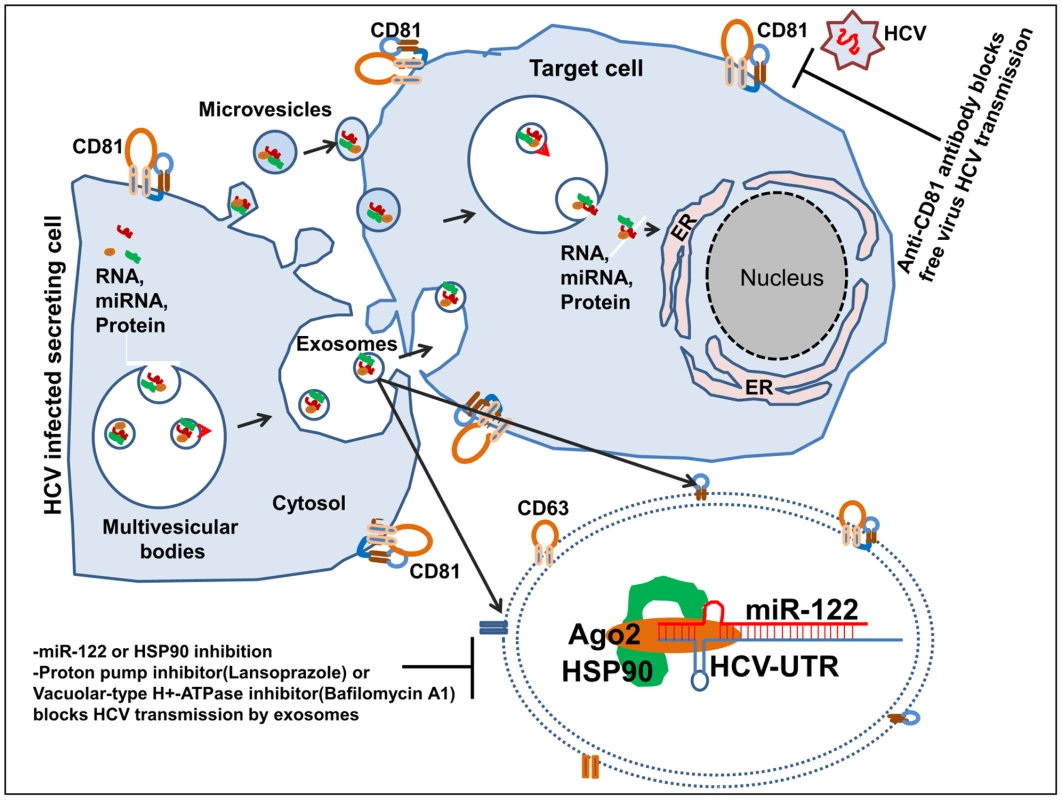
Materials and Methods
Cell lines, primary human hepatocytes (PHH) and HCV J6/JFH-1 virus
Huh7.5, Huh7.0 (a gift from Dr. Charlie Rice, Rockefeller University, New York) and CD81-deficient Huh7.25 [a gift from Dr. Takaji Wakita (National Institute of Infectious Disease, Tokyo, Japan) and Dr. T. Jake Liang (NIDDK, National Institutes of Health, USA)] cells were cultured as previously described [35], [49] with slight modification, using exosome depleted FBS (System Bioscience cat. #EXO-FBS-50A-1). Primary human hepatocytes were obtained from the National Institutes of Health (NIH) liver tissue cell distribution system (LTCDS; Minneapolis, MN, USA; Pittsburgh, PA; Richmond, VA, USA), which was funded by NIH contract #N01-DK-7-004/HHSN2670070004C and from BD Bioscience. Highly infectious and replication competent HCV J6/JFH-1 virus (genotype 2a) were generated as previously described [62]. The pFL-J6/JFH-1 plasmid used for virus generation was provided by Dr. Charlie Rice and Dr. Takaji Wakita (National Institute of Infectious Disease, Tokyo, Japan). HCV J6/JFH-1 virus concentration in culture supernatants was determined using NanoSight LM10 (MOI of infectious viral particles or infectious exosomes) and by quantitative real-time PCR as previously described [37].
Ethics statement
Subjects were recruited from the Hepatology clinic at the University of Massachusetts Medical School. This research protocol was reviewed by the Committee for the Protection of Human Subjects in Research at the University of Massachusetts Medical School (IRB #2284). All subjects who donated samples for this project provided signed written informed consent. Subjects were assessed for baseline demographics, Hepatitis C viral serology and liver function parameters (Table 1). Healthy control subjects had no evidence of systemic disease, HCV infection, or other liver diseases. Informed consent was obtained from all subjects. Blood samples were drawn and serum samples were analyzed for HCV RNA using RT-PCR and processed as subsequently indicated.
Exosome isolation and purification from cell lines and patient samples
Huh7.5 cells and HCV J6/JFH-1 infected Huh7.5 cells were maintained in DMEM low glucose medium supplemented with 10% exosome depleted FBS and 1% penicillin/streptomycin (Gibco, cat. #15140-163). Cell culture supernatants following cell infection or not, or patient serum samples were collected, centrifuged at 2500 rpm for 10 mins at 4°C to remove cell debris, then filtered through a 0.2 µm filter. The 40 mL of filtered culture supernatant for exosome isolation was concentrated to a final 1 mL volume using the Amicon Ultra-15 Centrifugal Filter Unit with Ultracel-100 membrane (Millipore, cat. #UFC910024). Concentrated culture supernatants or filtered patient serum (500 uL) were mixed with the appropriate volume of Exoquick-TC reagent (System Biosciences cat. #EXOTC10A-1) or Exoquick (System Bioscience cat. #EXOQ5A-1) respectively, for exosome isolation according to the manufacturers' specification. Samples were gently mixed and incubated for 1 h at 4°C. Following incubation, exosomes were precipitated by centrifugation at 1400 rpm for 10 mins at 4°C. The recovered exosomes were re-suspended in 1× phosphate buffered saline (PBS). Positive selection of exosomes was done using anti-CD63 immuno-magnetic capturing with primary anti-CD63 antibody (Abcam cat. #ab8219 and Santa Cruz cat. #15363) followed by corresponding secondary antibody coupled to magnetic beads (Miltenyi Biotec cat. #130-048-602). The Miltenyi Biotec MidiMACS separator was used with LD columns (cat. # 130-042-901) for exosome isolation.
Electron microscopy
Exosomes isolated by positive anti-CD63 immuno-magnetic bead selection were re-suspended in PBS and transferred to a formvar-coated copper grid then allowed to settle/attach for 30 minutes. The grid was washed by sequentially positioning droplets of PBS on top and using absorbing paper in between. The samples were then fixed by drop-wise addition of 2% paraformaldehyde onto parafilm and placing the grid on top of the paraformaldehyde drop for 10 min. Fixation was followed by five washes with deionized water and samples contrasted by adding 2% uranyl acetate for 15 minutes. Afterward, the samples were embedded by adding a drop of 0.13% methyl cellulose and 0.4% uranyl acetate for 10 minutes. The grid was visualized using a Philips CM10 transmission electron microscope and images were captured using a Gatan CCD digital camera.
Quantification of HCV-exosomes, purified HCV infectious virus particles and HCV RNA copy numbers
Quantification of immuno-magnetic CD63 bead captured infectious HCV J6/JFH-1-exosomes and HCV J6/JFH-1 virus preparations was determined using NanoSight LM10 system (NanoSight, Amesbury, UK) equipped with a fast video capture and Nanoparticle Tracking Analysis (NTA) system, according to the manufacturer's instructions. Quantification of HCV RNA copy numbers was done as previously described [31].
siRNA and miRNA inhibitor constructs and cell transfections
The following siRNA and miRNA inhibitors were used: human HSP90 siRNA (Santa Cruz cat. #sc-35608); control siRNA (Santa Cruz cat. #sc-44236), hsa-miR-122 anti-miR miRNA Inhibitor (Ambion, Austin, Tx cat. #AM11012) and anti-miR Negative Control (Ambion, Austin, Tx cat. #AM17010). miRNA or control inhibitors were complexed with the liver specific in vivo Altogen delivery reagent (Altogen Biosystems cat. #5060) which was loaded into control exosomes or HCV exosomes then co-cultured with target cells as indicated. Specific SiRNA or control siRNA was complexed with FugeneHD (Roche cat. # 04709705001) and transfected into target cells according to the manufacturer's specifications as indicated.
RNA Chromatin immunoprecipitation (ChIP) and co-immunoprecipitation analysis of exosome samples
Exosomes isolated from cell culture supernatants or patient serum samples were fixed at room temperature with 4% formaldehyde buffered saline. Afterward, exosomes were lysed in SDS ChIP lysis buffer (Millipore cat. # 20-163) supplemented with protease inhibitor and RNase inhibitor. Total exosome proteins were pre-cleared with protein G beads. 50 µg of total protein was incubated with Ago2 antibody. Immunoprecipitation was performed for 90 minutes at 4°C using 10 µg/ml primary Ago2 antibody and normal rabbit IgG (Santa Cruz cat # sc-2027) non-specific antibody used as IP control. A mixture of Protein A/G PLUS-Agarose beads (Santa Cruz cat. #sc-2003) was added, and the incubation was continued for an additional 60 minutes. The samples were washed with SDS ChIP lysis buffer supplemented with protease inhibitor and RNase inhibitor. The immunoprecipitated protein-RNA complex was either used for Western blot analysis or RNA purification after Ago2 pull down using the Zymo research Direct-zol RNA MiniPrep kit (cat. #R2050), according to the manufacturer's specification. TaqMan MicroRNA assay was used for quantification of miRNA, using a CFX Connect Real-Time PCR Detection System (Philadelphia, USA). The exosome miRNA data was normalized to Cel39 and fold change was calculated using delta-delta ct method as previously described [63].
Western blot analysis
Western blots were performed using the following established protocols. Briefly, proteins were resolved on 10% SDS-PAGE gels. After electrophoresis resolved proteins were transferred onto nitrocellulose membranes. Following protein transfer, membranes were blocked for 1 hour in PBS containing 5% non-fat dry milk and 0.1% Tween-20. Blots were then incubated overnight with primary antibody at 4°C. The following primary antibodies were used: anti-HCV NS3 (Abcam cat. #ab13830); anti-HSP90 (Cell Signaling cat. #4874); anti-CD63 (Abcam cat. #ab8219 used for western blotting and Santa Cruz Biotechnology cat. #sc-15363 used for exosomes purification); anti-Ago2 (Sigma cat. #SAB4200274); anti-CD81 (Santa Cruz Biotechnology cat. #sc-23962), normal rabbit IgG-AC antibody (Santa Cruz Biotechnology cat. # sc-2345); anti-beta actin [Ac-15] (Abcam, cat. #ab6276). The membranes were then incubated for 1 hour with horseradish peroxidase-conjugated secondary antibodies (dilution 1∶10,000) that included: goat anti-mouse IgG-HRP (Santa Cruz Biotechnology cat. #sc-2005); goat anti-rabbit IgG-HRP (Santa Cruz Biotechnology cat. #sc-2004). Finally, the proteins were visualized with the Clarity Western ECL substrate (BioRad, cat. #170-5061) chemiluminescence system according to the manufacturer's protocol using the Fujifilm LAS-4000 luminescent image analyzer.
Quantification of miRNA or HCV RNA expression in exosomes and cell lines
Prior to total RNA isolation, equal volume of plasma (500 µL) or 500 uL of 10 mL concentrated culture supernatant samples were thawed on ice, mixed with QIAzole (Qiagen), vortexed and incubated at RT for 5 mins. Synthetic C. elegans (cel)-miR-39 was spiked and after this step total RNA was extracted using Zymo research Direct-zol RNA MiniPrepKit as per instructions. TaqMan miRNA Assay (Applied Biosystems) was used to analyze the miRNA from serum or plasma samples. Cel-miR-39 was used to normalize the technical variation between the exosomes samples and when comparing miRNA or HCV RNA content in cell lines compared to exosomes. Quantification of miR-122 was performed using Taqman microRNA assays (Applied Biosystems). RNU48 was used as an endogenous control for miR-122 expression in cells and Cel-miR-39 was used as an exogenous control to normalize for technical variation in RNA isolation for determining miR-122 levels in exosomes.
Analysis of HCV positive and negative sense RNA
After RNA isolation as indicated, reverse transcription was performed by two different methods both of which were designed to amplify the 5′-UTR of HCV as previously described [37]. Briefly, positive sense RNA was amplified involving a first cDNA synthesis reaction using 500 ng of total RNA using the Bio-Rad cDNA synthesis kit according to the manufacturer's specification. The positive sense HCV 5′ UTR was then amplified using the following primer sequence: HCV Forward Primer: 5′-TCTGCGGAACCGGTGAGTAC-3′; HCV Reverse primer: 5′-TCAGGCAGTACCACAAGGCC-3′. HCV negative sense RNA was detected using primers and PCR conditions as previously described [64].
Vacuolar-type H+-ATPase inhibitor (bafilomycin A1), proton pump inhibitor (Lansoprazole) and for inhibition of HCV Huh 7.5 cells derived exosomes and virus entry/replication
Bafilomycin A1 was purchased from Sigma Aldrich and the proton pump inhibitor; Lansoprazole (Prevacid 24 hr OTC, Novartis), was purchased over the counter. Lansoprazole was dissolved in DMSO and applied to Huh7.5 cells at concentrations of 2.5 µg/ml, 5 µg/ml, and 10 µg/ml. Telaprevir (VX-950) was purchased from Selleckchem and used as previously described [65]. One hour later, HCV virus suspension and HCV infected exosomes (captured with CD63) were added to the cells. Twenty-four hour later, the cells were washed 3 times and assessed for viral structural protein, NS3. Bafilomycin A1 was dissolved in DMSO and applied to the Huh 7.5 cells at concentrations of 12.5 nM, 25 nM, 50 nM, and 100 nM, while the concentration of DMSO in the final treatments was 0.01%. One hour later, HCV virus suspension and HCV infected exosomes (captured with anti-CD63 antibody) were added to the cells. After 24 h, the cells were washed 3 times and assessed for viral RNA entry.
Lactate dehydrogenase (LDH) assay
The LDH toxicity assay kit (Abcam Cat. # ab65393) was used according to the manufacturer's specification. Briefly, released LDH in culture supernatants of Huh7.5 cells after 24 h co-culture with different concentration of Bafilomycin A1 and Lansoprazole was measured as the indicator of lysed cells. The percentage of cytotoxicity was measured by subtracting LDH content in remaining viable cells from total LDH in untreated controls. Staurosporine (20 nM) (Abcam, Cambridge, MA) treatment of Huh7.5 cells for 12 h was used as positive control. The final absorbance was measured at 490 nm. All experiments were performed in triplicate.
Blocking antibody experiments
Cells, as indicated, were treated with blocking antibodies to target HCV host receptors for one hour prior to infection with either HCV exosomes, HCV J6/JFH-1 virus or not as indicated. Blocking antibodies used included: anti-CD81 antibody (Santa Cruz Biotechnology cat. # sc-23962), anti-Scavenging Receptor (SR-BI) antibody (Abcam, cat. # ab52629), anti-HCV E2 antibody (GeneTex cat. # GTX103353) and anti-ApoE antibody (Millipore Cat. #: AB947).
Enzyme-Linked Immunosorbent Assay (ELISA) for APOE and APOB
Culture supernatants of Huh7.5 cells infected or non-infected with HCV (J6/JFH-1) were centrifuged at 1,000× rpm for 10 minutes to remove cells followed by another spin at 2,000× rpm for 15 minutes to remove cellular debris. Exosomes were positively selected with CD63 immunomagnetic beads as described above and the flow through collected which included cell free virus and viral particles. Levels of APOE and APOB proteins in the exosomes were identified by using Apolipoprotein E (APOE) Human ELISA Kit (Abcam cat # ab108813) and Human Apolipoprotein B (APOB) Quantikine ELISA Kit (R&D Systems cat # DAPB00) according to the manufacturers' protocols. The same number of control exosomes (obtained from non-infected Huh 7.5 cells), exosomes derived from HCV infected Huh 7.5 cells and viral particles were used for the experiment and quantified by Nanosight measurements. The optical density of the color reactions for both plates was read on plate reader at 450 nm. Standard curves were generated and concentrations of APOE and APOB were calculated as stipulated in the manufacturer's protocol. Liver cell protein lysate was used as positive control.
Statistical analysis
Data are representative of at least 3 independently repeated experiments presented as mean + standard error of the mean (SEM). A non-parametric Mann-Whitney U test and multiple comparisons for repeated-measures were done using ANOVA performed with GraphPad Prism Version 5.0 (GraphPad Software). A p value of <0.05 was considered significant.
Supporting Information
Zdroje
1. ShepardCW, FinelliL, AlterMJ (2005) Global epidemiology of hepatitis C virus infection. The Lancet infectious diseases 5: 558–567.
2. NegroF, AlbertiA (2011) The global health burden of hepatitis C virus infection. Liver international : official journal of the International Association for the Study of the Liver 31 Suppl 2: 1–3.
3. ScheelTK, RiceCM (2013) Understanding the hepatitis C virus life cycle paves the way for highly effective therapies. Nature medicine 19: 837–849.
4. RubinA, AguileraV, BerenguerM (2011) Liver transplantation and hepatitis C. Clinics and research in hepatology and gastroenterology 35: 805–812.
5. FormanLM (2003) To transplant or not to transplant recurrent hepatitis C and liver failure. Clinics in liver disease 7: 615–629.
6. TimpeJM, StamatakiZ, JenningsA, HuK, FarquharMJ, et al. (2008) Hepatitis C virus cell-cell transmission in hepatoma cells in the presence of neutralizing antibodies. Hepatology 47: 17–24.
7. MorinTJ, BroeringTJ, LeavBA, BlairBM, RowleyKJ, et al. (2012) Human monoclonal antibody HCV1 effectively prevents and treats HCV infection in chimpanzees. PLoS pathogens 8: e1002895.
8. GottweinJM, BukhJ (2008) Cutting the gordian knot-development and biological relevance of hepatitis C virus cell culture systems. Advances in virus research 71: 51–133.
9. ZeiselMB, FofanaI, Fafi-KremerS, BaumertTF (2011) Hepatitis C virus entry into hepatocytes: molecular mechanisms and targets for antiviral therapies. Journal of hepatology 54: 566–576.
10. ScarselliE, AnsuiniH, CerinoR, RoccaseccaRM, AcaliS, et al. (2002) The human scavenger receptor class B type I is a novel candidate receptor for the hepatitis C virus. The EMBO journal 21: 5017–5025.
11. PileriP, UematsuY, CampagnoliS, GalliG, FalugiF, et al. (1998) Binding of hepatitis C virus to CD81. Science 282: 938–941.
12. MeulemanP, HesselgesserJ, PaulsonM, VanwolleghemT, DesombereI, et al. (2008) Anti-CD81 antibodies can prevent a hepatitis C virus infection in vivo. Hepatology 48: 1761–1768.
13. DavisGL (2006) Hepatitis C immune globulin to prevent HCV recurrence after liver transplantation: chasing windmills? Liver transplantation : official publication of the American Association for the Study of Liver Diseases and the International Liver Transplantation Society 12: 1317–1319.
14. ManciniN, DiottiRA, PerottiM, SauttoG, ClementiN, et al. (2009) Hepatitis C virus (HCV) infection may elicit neutralizing antibodies targeting epitopes conserved in all viral genotypes. PloS one 4: e8254.
15. SchianoTD, CharltonM, YounossiZ, GalunE, PruettT, et al. (2006) Monoclonal antibody HCV-AbXTL68 in patients undergoing liver transplantation for HCV: results of a phase 2 randomized study. Liver transplantation : official publication of the American Association for the Study of Liver Diseases and the International Liver Transplantation Society 12: 1381–1389.
16. WitteveldtJ, EvansMJ, BitzegeioJ, KoutsoudakisG, OwsiankaAM, et al. (2009) CD81 is dispensable for hepatitis C virus cell-to-cell transmission in hepatoma cells. The Journal of general virology 90: 48–58.
17. LeeY, El AndaloussiS, WoodMJ (2012) Exosomes and microvesicles: extracellular vesicles for genetic information transfer and gene therapy. Human molecular genetics 21: R125–134.
18. TheryC, ZitvogelL, AmigorenaS (2002) Exosomes: composition, biogenesis and function. Nature reviews Immunology 2: 569–579.
19. Momen-HeraviF, BalajL, AlianS, TiggesJ, ToxavidisV, et al. (2012) Alternative methods for characterization of extracellular vesicles. Frontiers in physiology 3: 354.
20. YangM, ChenJ, SuF, YuB, SuF, et al. (2011) Microvesicles secreted by macrophages shuttle invasion-potentiating microRNAs into breast cancer cells. Molecular cancer 10: 117.
21. PietschmannT, LohmannV, KaulA, KriegerN, RinckG, et al. (2002) Persistent and transient replication of full-length hepatitis C virus genomes in cell culture. Journal of virology 76: 4008–4021.
22. GastaminzaP, DrydenKA, BoydB, WoodMR, LawM, et al. (2010) Ultrastructural and biophysical characterization of hepatitis C virus particles produced in cell culture. Journal of virology 84: 10999–11009.
23. MasciopintoF, GiovaniC, CampagnoliS, Galli-StampinoL, ColombattoP, et al. (2004) Association of hepatitis C virus envelope proteins with exosomes. European journal of immunology 34: 2834–2842.
24. DreuxM, GaraigortaU, BoydB, DecembreE, ChungJ, et al. (2012) Short-range exosomal transfer of viral RNA from infected cells to plasmacytoid dendritic cells triggers innate immunity. Cell Host Microbe 12: 558–570.
25. WakitaT, PietschmannT, KatoT, DateT, MiyamotoM, et al. (2005) Production of infectious hepatitis C virus in tissue culture from a cloned viral genome. Nature medicine 11: 791–796.
26. WilsonJA, ZhangC, HuysA, RichardsonCD (2011) Human Ago2 is required for efficient microRNA 122 regulation of hepatitis C virus RNA accumulation and translation. Journal of virology 85: 2342–2350.
27. HenkeJI, GoergenD, ZhengJ, SongY, SchuttlerCG, et al. (2008) microRNA-122 stimulates translation of hepatitis C virus RNA. The EMBO journal 27: 3300–3310.
28. JoplingCL, SchutzS, SarnowP (2008) Position-dependent function for a tandem microRNA miR-122-binding site located in the hepatitis C virus RNA genome. Cell host & microbe 4: 77–85.
29. JoplingCL, YiM, LancasterAM, LemonSM, SarnowP (2005) Modulation of hepatitis C virus RNA abundance by a liver-specific MicroRNA. Science 309: 1577–1581.
30. JangraRK, YiM, LemonSM (2010) Regulation of hepatitis C virus translation and infectious virus production by the microRNA miR-122. Journal of virology 84: 6615–6625.
31. BukongTN, HouW, KodysK, SzaboG (2013) Ethanol facilitates hepatitis C virus replication via up-regulation of GW182 and heat shock protein 90 in human hepatoma cells. Hepatology 57: 70–80.
32. WileyRD, GummuluruS (2006) Immature dendritic cell-derived exosomes can mediate HIV-1 trans infection. Proceedings of the National Academy of Sciences of the United States of America 103: 738–743.
33. RiceCM (2011) New insights into HCV replication: potential antiviral targets. Topics in antiviral medicine 19: 117–120.
34. BroeringTJ, GarrityKA, BoatrightNK, SloanSE, SandorF, et al. (2009) Identification and characterization of broadly neutralizing human monoclonal antibodies directed against the E2 envelope glycoprotein of hepatitis C virus. Journal of virology 83: 12473–12482.
35. AkazawaD, DateT, MorikawaK, MurayamaA, MiyamotoM, et al. (2007) CD81 expression is important for the permissiveness of Huh7 cell clones for heterogeneous hepatitis C virus infection. Journal of virology 81: 5036–5045.
36. BartoschB, DubuissonJ, CossetFL (2003) Infectious hepatitis C virus pseudo-particles containing functional E1-E2 envelope protein complexes. The Journal of experimental medicine 197: 633–642.
37. BukongTN, HouW, KodysK, SzaboG (2012) Ethanol facilitates HCV replication via upregulation of GW182 and HSP90 in human hepatoma cells. Hepatology 10.1002/hep.26010.
38. ShimakamiT, YamaneD, JangraRK, KempfBJ, SpanielC, et al. (2012) Stabilization of hepatitis C virus RNA by an Ago2-miR-122 complex. Proceedings of the National Academy of Sciences of the United States of America 109: 941–946.
39. ShimakamiT, YamaneD, JangraRK, KempfBJ, SpanielC, et al. (2012) Stabilization of hepatitis C virus RNA by an Ago2-miR-122 complex. Proceedings of the National Academy of Sciences of the United States of America 109: 941–946.
40. UjinoS, YamaguchiS, ShimotohnoK, TakakuH (2009) Heat-shock protein 90 is essential for stabilization of the hepatitis C virus nonstructural protein NS3. J Biol Chem 284: 6841–6846.
41. TscherneDM, JonesCT, EvansMJ, LindenbachBD, McKeatingJA, et al. (2006) Time- and temperature-dependent activation of hepatitis C virus for low-pH-triggered entry. Journal of virology 80: 1734–1741.
42. MeertensL, BertauxC, DragicT (2006) Hepatitis C virus entry requires a critical postinternalization step and delivery to early endosomes via clathrin-coated vesicles. Journal of virology 80: 11571–11578.
43. ParoliniI, FedericiC, RaggiC, LuginiL, PalleschiS, et al. (2009) Microenvironmental pH is a key factor for exosome traffic in tumor cells. The Journal of biological chemistry 284: 34211–34222.
44. SimonsM, RaposoG (2009) Exosomes–vesicular carriers for intercellular communication. Current opinion in cell biology 21: 575–581.
45. Momen-HeraviF, BalajL, AlianS, MantelPY, HalleckAE, et al. (2013) Current methods for the isolation of extracellular vesicles. Biological chemistry 10.1515/hsz-2013-0141.
46. SilvermanJM, ReinerNE (2011) Exosomes and other microvesicles in infection biology: organelles with unanticipated phenotypes. Cellular microbiology 13: 1–9.
47. BhatnagarS, ShinagawaK, CastellinoFJ, SchoreyJS (2007) Exosomes released from macrophages infected with intracellular pathogens stimulate a proinflammatory response in vitro and in vivo. Blood 110: 3234–3244.
48. RamakrishnaiahV, ThumannC, FofanaI, HabersetzerF, PanQ, et al. (2013) Exosome-mediated transmission of hepatitis C virus between human hepatoma Huh7.5 cells. Proceedings of the National Academy of Sciences of the United States of America 110: 13109–13113.
49. BlightKJ, McKeatingJA, RiceCM (2002) Highly permissive cell lines for subgenomic and genomic hepatitis C virus RNA replication. Journal of virology 76: 13001–13014.
50. HaoJ, JinW, LiX, WangS, ZhangX, et al. (2013) Inhibition of alpha interferon (IFN-alpha)-induced microRNA-122 negatively affects the anti-hepatitis B virus efficiency of IFN-alpha. J Virol 87: 137–147.
51. Sarasin-FilipowiczM, KrolJ, MarkiewiczI, HeimMH, FilipowiczW (2009) Decreased levels of microRNA miR-122 in individuals with hepatitis C responding poorly to interferon therapy. Nature medicine 15: 31–33.
52. JohnstonM, GeoffroyMC, SobalaA, HayR, HutvagnerG (2010) HSP90 protein stabilizes unloaded argonaute complexes and microscopic P-bodies in human cells. Molecular biology of the cell 21: 1462–1469.
53. OkamotoT, NishimuraY, IchimuraT, SuzukiK, MiyamuraT, et al. (2006) Hepatitis C virus RNA replication is regulated by FKBP8 and Hsp90. The EMBO journal 25: 5015–5025.
54. UjinoS, YamaguchiS, ShimotohnoK, TakakuH (2009) Heat-shock protein 90 is essential for stabilization of the hepatitis C virus nonstructural protein NS3. J Biol Chem 284: 6841–6846.
55. TheryC, ZitvogelL, AmigorenaS (2002) Exosomes: composition, biogenesis and function. Nature reviews Immunology 2: 569–579.
56. DenzerK, KleijmeerMJ, HeijnenHF, StoorvogelW, GeuzeHJ (2000) Exosome: from internal vesicle of the multivesicular body to intercellular signaling device. Journal of cell science 113 Pt 19: 3365–3374.
57. SobotaJA, BackN, EipperBA, MainsRE (2009) Inhibitors of the V0 subunit of the vacuolar H+-ATPase prevent segregation of lysosomal- and secretory-pathway proteins. Journal of cell science 122: 3542–3553.
58. Alvarez-ErvitiL, SeowY, SchapiraAH, GardinerC, SargentIL, et al. (2011) Lysosomal dysfunction increases exosome-mediated alpha-synuclein release and transmission. Neurobiology of disease 42: 360–367.
59. VingtdeuxV, HamdaneM, LoyensA, GeleP, DrobeckH, et al. (2007) Alkalizing drugs induce accumulation of amyloid precursor protein by-products in luminal vesicles of multivesicular bodies. The Journal of biological chemistry 282: 18197–18205.
60. BlanchardE, BelouzardS, GoueslainL, WakitaT, DubuissonJ, et al. (2006) Hepatitis C virus entry depends on clathrin-mediated endocytosis. Journal of virology 80: 6964–6972.
61. LimJH, ParkJW, KimMS, ParkSK, JohnsonRS, et al. (2006) Bafilomycin induces the p21-mediated growth inhibition of cancer cells under hypoxic conditions by expressing hypoxia-inducible factor-1alpha. Molecular pharmacology 70: 1856–1865.
62. LindenbachBD, EvansMJ, SyderAJ, WolkB, TellinghuisenTL, et al. (2005) Complete replication of hepatitis C virus in cell culture. Science 309: 623–626.
63. BalaS, PetrasekJ, MundkurS, CatalanoD, LevinI, et al. (2012) Circulating microRNAs in exosomes indicate hepatocyte injury and inflammation in alcoholic, drug-induced, and inflammatory liver diseases. Hepatology 56: 1946–1957.
64. ItoT, MukaigawaJ, ZuoJ, HirabayashiY, MitamuraK, et al. (1996) Cultivation of hepatitis C virus in primary hepatocyte culture from patients with chronic hepatitis C results in release of high titre infectious virus. The Journal of general virology 77 (Pt 5) 1043–1054.
65. BukongTN, KodysK, SzaboG (2013) Human ezrin-moesin-radixin proteins modulate hepatitis C virus infection. Hepatology 58: 1569–1579.
Štítky
Hygiena a epidemiologie Infekční lékařství LaboratořČlánek vyšel v časopise
PLOS Pathogens
2014 Číslo 10
- Diagnostický algoritmus při podezření na syndrom periodické horečky
- Stillova choroba: vzácné a závažné systémové onemocnění
- Perorální antivirotika jako vysoce efektivní nástroj prevence hospitalizací kvůli COVID-19 − otázky a odpovědi pro praxi
- Choroby jater v ordinaci praktického lékaře – význam jaterních testů
- Jak souvisí postcovidový syndrom s poškozením mozku?
Nejčtenější v tomto čísle
- Novel Cyclic di-GMP Effectors of the YajQ Protein Family Control Bacterial Virulence
- MicroRNAs Suppress NB Domain Genes in Tomato That Confer Resistance to
- The ESAT-6 Protein of Interacts with Beta-2-Microglobulin (β2M) Affecting Antigen Presentation Function of Macrophage
- Characterization of Uncultivable Bat Influenza Virus Using a Replicative Synthetic Virus
